

Edwebet103 - Digital Reading - Google Slides. Britannica LumieLabs Helps Students Become Digital Storytellers; Groundbreaking Video-Production Platform Promotes Media Literacy, Curiosity, Creativity, Collaboration - Chicago Business Journal. CHICAGO, Jan. 22, 2019 /PRNewswire-PRWeb/ -- Britannica LumieLabs Helps Students Become Digital Storytellers Groundbreaking video-production platform promotes media literacy, inquiry, curiosity, creativity and collaboration Students and educators across the world can become accomplished digital storytellers with LumieLabs™, a powerful yet intuitive online platform from Britannica Digital Learning.
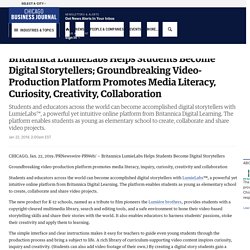
The platform enables students as young as elementary school to create, collaborate and share video projects. The new product for K-12 schools, named as a tribute to film pioneers the Lumière brothers, provides students with a copyright-cleared multimedia library, search and editing tools, and a safe environment to hone their video-based storytelling skills and share their stories with the world. Eli Pariser: Beware online "filter bubbles". 8 digital skills we must teach our children. The social and economic impact of technology is widespread and accelerating.
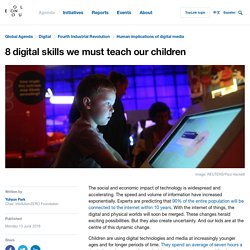
The speed and volume of information have increased exponentially. Experts are predicting that 90% of the entire population will be connected to the internet within 10 years. With the internet of things, the digital and physical worlds will soon be merged. These changes herald exciting possibilities. But they also create uncertainty. Information Literacy. November 2014: Literacies for the digital age: Media literacy. This is the third in a series of blog posts highlighting the digital literacies our students will need to succeed.

The first post dealt with financial literacy, the second with visual literacy, and this one will provide you with some ideas on how to infuse media literacy into the curriculum. The literacies I feel need to be explored, practiced and mastered by students can be found in the graphic below. There are many areas of media literacy. Media Literacy Project has a wonderful document that presents the components of media literacy in a straightforward fashion and includes useful lists of the various concepts of this literacy. Information & Media Literacy. Information & Media LiteracyWhat is Media?
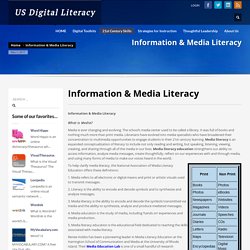
Media is ever changing and evolving. The school’s media center used to be called a library. It was full of books and nothing much more than print media. Fact Check now available in Google Search and News around the world. Top 10 sites to help students check their facts. 50 Activities To Promote Digital Media Literacy In Students. 50 Challenging Activities To Promote Digital Media Literacy In Students by Terry Heick Literacy is changing–not at its core necessarily, but certainly at its edges as it expands to include new kinds of “reading.”
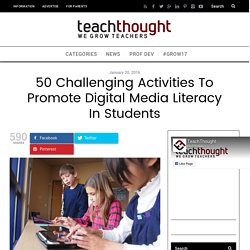
Digital media is quickly replacing traditional media forms as those most accessible to most 21st century learners. The impact of this change is extraordinarily broad, but for now we’ll narrow it down to changes in how learners respond to the media they consume. The most fundamental pattern of formal academia is to read something and then write about it. Some of these tasks will look familiar, especially to English teachers.
Also, I know that medium is the singular form and media the plural, but to me the connotation of the word medium hints at the form (e.g., film, text, video), whereas the media seems more apt to refer to a specific example of a media form (Schindler’s List, The Odyssey, Charlie Bit Me). 10 resources to boost student media literacy. Share your work. Literacy, media and technology resources for teachers. Multimodal Literacies and Technology. “Has there ever been a time when we have not been awash in a remarkable torrent of symbols and opportunities for reading and writing them?”
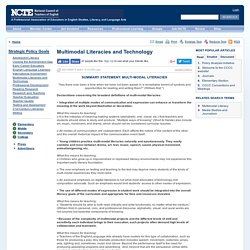
(William Kist *) Declarations concerning the broadest definitions of multi-modal literacies: • Integration of multiple modes of communication and expression can enhance or transform the meaning of the work beyond illustration or decoration. What this means for teaching:o It is the interplay of meaning-making systems (alphabetic, oral, visual, etc.) that teachers and students should strive to study and produce. “Multiple ways of knowing” (Short & Harste) also include art, music, movement, and drama, which should not be considered curricular luxuries. o All modes of communication are codependent. . • Young children practice multi-modal literacies naturally and spontaneously. What this means for teaching:o Children who grow up in impoverished or repressed literacy environments may not experience this important early literacy foundation. Paper or Tablet? Reading Recall and Comprehension. What effect do digital devices have on our digital brains?

To uncover the influence on learning of using digital tablets for reading, the Coast Guard Leadership Development Center conducted an experiment to ascertain differences in recall and comprehension between tablet and paper readers. As of 2014, 63 percent of colleges reported using e-textbooks, while 27 percent planned to in the near future.1 But what drives these digital book policies and practices in higher education — technology or research?
Considering the pervasiveness of digital devices, the lack of sufficient guidance for educators to make informed decisions about instruction and learning is disconcerting. Despite the widespread adoption of tablets in schools, ranging from elementary through higher education, research about the effects of tablet use on student learning has obvious gaps. Strategies to Help Students ‘Go Deep’ When Reading Digitally. Students are doing more reading on digital devices than they ever have before.

Not only are many teachers using tablets and computers for classroom instruction, but many state tests are now administered on computers, adding incentive for teachers to teach digital reading strategies. But casual digital reading on the internet has instilled bad habits in many students, making it difficult for them to engage deeply with digital text in the same way they do when reading materials printed on paper. Devin Hess sympathizes with educators’ concerns, but believes digital reading is here to stay and teachers have a duty to equip students to engage with digital texts in meaningful ways. Hess was a middle school social studies teacher and early tech adopter in his classroom. Now he works with the UC Berkeley History-Social Science Project training social studies teachers on deep reading strategies. “I don’t believe technology should ever be taught separately,” Hess said. Can Students ‘Go Deep’ With Digital Reading?
Mark Pennington’s students often read on their laptops.
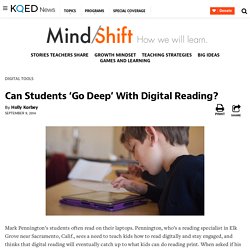
Pennington, who’s a reading specialist in Elk Grove near Sacramento, Calif., sees a need to teach kids how to read digitally and stay engaged, and thinks that digital reading will eventually catch up to what kids can do reading print. When asked if his seventh-graders are more engaged when reading from digital readers or in print, he said it depends — motivation and environment play a big role. “Most of the digital reading that students ‘practice’ is at home on Instagram, chat lines, Facebook and texting,” he said. “Since students are choosing to read and respond in these mediums, and since students have considerable prior knowledge and expertise in the subject matter, their engagement/comprehension is high.”
The trick to being a good reader, no matter the medium, is being an engaged reader, a fact that Pennington notes is well-supported by research. Making Learning Visible: Doodling Helps Memories Stick. Shelley Paul and Jill Gough had heard that doodling while taking notes could help improve memory and concept retention, but as instructional coaches they were reluctant to bring the idea to teachers without trying it out themselves first.
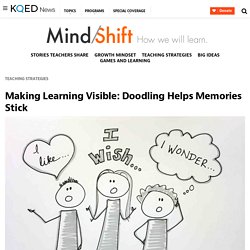
To give it a fair shot, Paul tried sketching all her notes from a two-day conference. By the end, her drawings had improved and she was convinced the approach could work for kids, too. “It causes you to listen at a different level,” said Jill Gough, director of teaching and learning at Trinity Schools. Doodling has long been seen as a sign that students aren’t paying attention. But it may be time to give doodling an image makeover. 18 Digital Tools and Strategies That Support Students’ Reading and Writing. Teachers in Littleton, Colorado — like teachers in many places — are increasingly asking students to read and write online.
Free tools like Google Docs have made it easy for students to work on the same piece of writing at home and at school, and have allowed teachers to explore collaborative writing assignments and synchronous editing with students. There are also many digital tools that can support students as they learn how to read deeply, take well-cited notes, and navigate the writing process. Social Media Connects Students to Authors. Teaching Students the Skills to Be Savvy Researchers. Beyond Text. Media Literacy vs Bogus News. As Media Landscape Changes Librarians Take on New Roles. Teaching Shakespeare in the 21st Century Way. How Should Elementary Schools Teach Reading in An Age of Computers.
Digital Literacy Forging Agreement on a Definition. Teaching Literacy Outside of English Class. Digital Citizenship Initiative Will Target State Legislators. Untitled The Changing Face of Literacy. A Small Nod for Digital Skills. Technology, Reading & Digital Literacy Strategies to Engage the Reluctant Reader L. Robert Furman. Tools to Take Literacy Online.